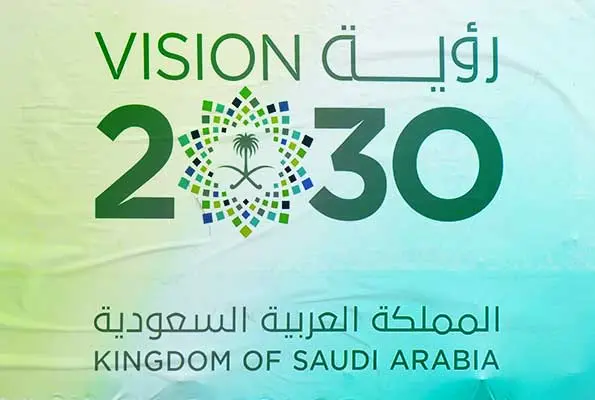With “Vision 2030” economic diversification agenda halfway complete, Saudi Arabia’s grandiose goal to reshape the nation and move away from oil dependency confronts financial challenges, causing it to scale back its most ambitious projects.
At the World Economic Forum on April 28, Finance Minister Mohammed Al Jadaan said the Kingdom would “downscale” or “accelerate” Vision 2030 projects to address economic and geopolitical concerns. That followed Al Jadaan’s December 2023 announcement of project delays.
Importantly, in April 2024, Saudi Arabia announced that it would reduce the capacity of its USD 1.5 trillion futuristic and green megacity, NEOM.
The Line, a NEOM subproject, was going to shelter 1.5 million people in the desert, but today it can only house 300,000.
The initial plan called for a 500-metre (546-yard), mirrored, 170-kilometre (105-mile) parallel tower line. Recent adjustments have cut the Line by 98.6% to 2.4 kilometres (1.49 miles).
“I don’t think I’ve ever met anyone who believed it would be built as planned, Saudis included,” Rice University Baker Institute energy research fellow Jim Krane told The New Arab.
“Building a 100-mile skyscraper in the midst of nowhere is a waste of scarce resources,” the analyst continued further.
The Signs Are Unclear
Vision 2030 progress messages are conflicting.
Despite major changes from NEOM’s blueprint, the Saudi government has tried to promote Vision 2030 as being on track.
At the World Economic Forum’s special conference in Riyadh on April 30, Economy Minister Faisal Al Ibrahim told CNBC that “all projects are proceeding full steam ahead” and that “there is no change in scale” for NEOM.
However, a February Citigroup research found mixed results for Vision 2030. On one hand, female labour participation, unemployment, and non-oil fiscal revenues have improved.
Despite progress in other areas, Citigroup says Saudi Arabia still needs to attract foreign investment, tourism, and non-oil exports to diversify.
As the brainchild of 38-year-old Crown Prince Mohammad bin Salman, Vision 2030 aims to move Saudi Arabia away from oil and boost its global influence.
This includes boosting manufacturing, artificial intelligence (AI), clean energy, sports, and entertainment, as well as NEOM and Sindalah, a Red Sea luxury tourism island.
Saudi Arabia has also offered lucrative Hajj and Umrah packages in Mecca and Medina, Islam’s holiest cities.
To shed its ultra-conservative reputation, the Saudi government has liberalised women’s rights and social restrictions.
Offsetting lower oil demand requires investment in alternative energy sources, including the “region’s largest” green-hydrogen plant, Al Shuaibah.
“Some of the more practical giga-projects that supply housing or engage in decarbonising elements of the Saudi energy sector should be fine,” said Jim Krane.
Dependence On Oil
Vision 2030’s goals aside, oil will undoubtedly remain vital to Saudi Arabia’s economy.
In March, Aramco CEO and President Amin Nasser stated the world should “abandon the dream of phasing out oil and gas,” confirming Saudi Arabian beliefs that fossil fuels may be difficult to replace.
The 1930s discovery of oil under the plains in Dhahran in Saudi Arabia’s eastern regions made the Kingdom a regional power that global actors had to engage with.
“Despite NEOM’s major deviation from the original blueprint, the Saudi government has endeavoured to promote Vision 2030 as on track,” Nasser told further.
Major “Vision 2030” projects rely on the state-owned Public Investment Fund, or PIF, which obtains most of its funding from oil. Its “Vision 2030” ambitions may depend on financial market movements due to its oil dependence.
International crude oil prices must reach USD 86 per barrel for Saudi Arabia’s “Vision 2030” to succeed, according to the IMF. It may need higher prices due to oil output cuts.
Economic shocks like the 2020 COVID-19 lockdowns, which temporarily lowered oil prices below zero, and Russia’s invasion of Ukraine, which raised oil prices to USD 136 per in March 2022, have all affected Saudi Arabia’s spending.
If oil prices fall, Saudi Arabia will struggle to fund its initiatives.
Steffen Hertog, associate professor at the London School of Economics and Political Science, told The New Arab that many “Vision 2030” giga-projects have very large budgets and have received little matched private investment.
Dr. Hertog said, “Some budget adjustment at this time is perhaps a sign of more mature policymaking; it would have been worse to run with very high budgets for longer until the money runs out”.
He said social and regulatory changes could continue despite Saudi Arabia’s budget constraints.
Attracting investments may remain vital. However, Saudi Arabia has suffered in this endeavour due to too ambitious ambitions.
“Potential investors have gone to the Kingdom and listened to the pitches, but few opened their wallets. Since foreigners won’t pay, Saudis must,” said Jim Krane.
Riyadh stated in April 2024 that it would sell domestic and foreign bonds to finance a record amount of debt for “Vision 2030.” Bloomberg reports that lenders may issue USD 11.5 billion in bonds to maintain “Vision 2030.”
However, regional and global tensions have made domestic and international investors increasingly cautious.
“Failing to meet Vision 2030 goals could raise major issues about the massive economic cost of these initiatives, especially as the Kingdom’s cost of living rises,” Krane commented further.
“The prolonged fighting in Gaza, along with rising Houthi activity [in the Red Sea] and escalating turmoil in Jordan, has the Kingdom worried about the future,” Lancaster University Professor of International Politics Simon Mabon told The New Arab.
IMF’s newest regional outlook study predicts Saudi Arabia’s GDP will grow 2.6% in 2024, down from 4% in October, amid regional tensions and oil supply restrictions.
Thus, Riyadh may hope regional tensions, which have hampered its economy, dissipate.
Saudi Arabia’s ambitious reform has changed its image internationally and domestically, but its long-term success is uncertain.



